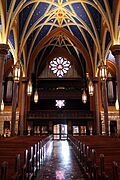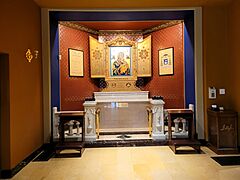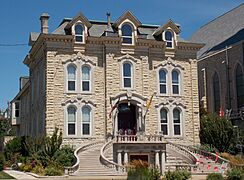Cathedral of Saint Mary of the Immaculate Conception (Peoria, Illinois) facts for kids
Quick facts for kids Cathedral of Saint Mary of the Immaculate Conception |
|
|---|---|

Cathedral of Saint Mary of the Immaculate Conception in 2023
|
|
| 40°41′54.9″N 89°35′6.1″W / 40.698583°N 89.585028°W | |
| Location | 607 NE Madison Ave. Peoria, Illinois |
| Country | United States |
| Denomination | Roman Catholic Church |
| History | |
| Status | Cathedral |
| Founded | 1846 |
| Architecture | |
| Functional status | Active |
| Architect(s) | Casper Mehler |
| Style | Gothic Revival |
| Groundbreaking | 1885 |
| Completed | 1889 |
| Specifications | |
| Length | 170 feet (52 m) |
| Width | 80 feet (24 m) |
| Number of spires | Two |
| Spire height | 230 feet (70 m) |
| Materials | Anamosa Limestone |
| Administration | |
| Diocese | Peoria |
The Cathedral of Saint Mary of the Immaculate Conception, often called St. Mary's Cathedral, is a big Catholic church in Peoria, Illinois, United States. It's the main church for the Diocese of Peoria. A famous Catholic leader, Archbishop Fulton J. Sheen, was born, grew up, and became a priest here. Since 2019, his resting place has been inside this cathedral. The building is also a special historical landmark listed on the National Register of Historic Places.
Contents
History of St. Mary's Cathedral
Early Beginnings in Peoria
The first Catholic Mass in the Peoria area happened at Fort Crevecoeur. This was across the Illinois River from where Peoria is today. Priests from the Récollets group, like Father Gabriel Ribourde, Father Zenobius Membre, and Father Louis Hennepin, were there.
In 1839, Father Reho celebrated Mass in the city of Peoria. Then, in 1846, Father John A. Drew started St. Mary's Church. The first church building that would later become St. Mary's Cathedral was built in 1851.
Building the Current Cathedral
The current cathedral was designed by an architect from Chicago named Casper Mehler. He wanted it to look like St. Patrick's Cathedral in New York City. The first stone for the new building was placed on June 28, 1885, by Bishop John Lancaster Spalding.
Construction of the cathedral was finished in 1889. The outside of the church is made of Anamosa Limestone. The two tall spires on the front of the building reach a height of 230 feet (70 meters).
Special Features and Art
Inside the cathedral, there is a painting of the Crucifix behind the altar. This painting was created in 1873 by a Spanish artist named Yzquierda. Bishop Spalding bought it, and it used to hang in the old cathedral. This painting and a bell in the south tower are the only things left from the original St. Mary's Church, which was taken down in 1898.
The church's large pipe organ was installed in 1936. It was made by the Wicks Organ Company and has 3,329 pipes.
Historical Landmark Status
Both the cathedral and the nearby Bishop's House are important historical buildings. They are part of the North Side Historic District. This district was added to the National Register of Historic Places in 1983.
Important Visitors and Renovations
In 1995, Mother Teresa, a very famous nun known for her charity work, visited St. Mary's. A special Mass was held in her honor.
The cathedral had a big renovation project that started in 2014 and finished in 2016. This work helped to restore and update parts of the building.
Archbishop Fulton J. Sheen's Resting Place
On June 27, 2019, the remains of Archbishop Fulton J. Sheen were moved to St. Mary's Cathedral. He had been buried in St. Patrick's Cathedral in New York since 1979. His remains are now in a marble monument at a side altar dedicated to Our Lady of Perpetual Help.
As a child, Fulton J. Sheen was an altar boy at St. Mary's Cathedral. He became a priest here in 1919 for the Diocese of Peoria. The Diocese of Peoria has been working to have him recognized as a saint.
Interments
- Venerable Fulton J. Sheen
See also
 In Spanish: Catedral de Santa María de la Inmaculada Concepción (Peoria) para niños
In Spanish: Catedral de Santa María de la Inmaculada Concepción (Peoria) para niños
Images for kids








